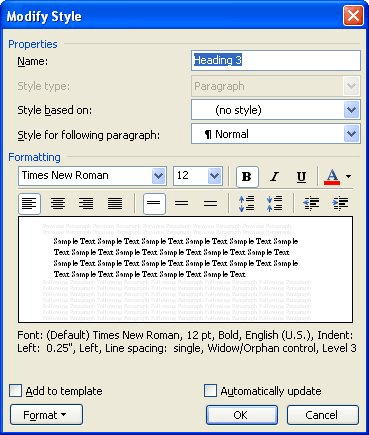Please Note: This article is written for users of the following Microsoft Word versions: 97, 2000, 2002, and 2003. If you are using a later version (Word 2007 or later), this tip may not work for you. For a version of this tip written specifically for later versions of Word, click here: Numbering on New Paragraph Doesn't Work as Expected.
Written by Allen Wyatt (last updated March 26, 2016)
This tip applies to Word 97, 2000, 2002, and 2003
Joel is setting up a template in Word that uses outline numbering. When he sets the insertion point at the end of a line and presses Enter, the numbering does not continue. The only thing that works is moving the insertion point to the left of the period at the end of the line and then pressing Enter. This carries the period to the next paragraph and the new paragraph then has the proper numbering format. Joel wonders how to avoid using that crutch. He wants others who use the template to hit Enter and just keep typing the next item in the outline with no problem.
The most likely cause of this behavior is actually a built-in feature of Word. When you define a style you can specify what style should be used for the paragraph that follows this one. That may sound confusing, but it isn't really that tough if you remember that Word allows you to specify what style should be applied to the next paragraph you type, after you press Enter. You can set up that capability for an existing style by following these steps in Word 2002 or Word 2003:

Figure 1. The Modify Style dialog box.
If you are using Word 97 or Word 2000 you should follow these steps, instead:
There are some caveats that you should keep in mind. First, you'll want to pay attention to which styles you are modifying and whether your modification makes sense for all the uses for which the style may be used. For instance, if you are using a numbering scheme that is linked, in some way, to the heading styles defined in Word, you may not want to change the "Style for Following Paragraph" setting for your heading styles. The reason is because there are many times where you want the style after a Heading to naturally be whatever style you are using for your body text, not another instance of the same heading.
In this case, the solution is to make sure that you set up a group of styles that will be used specifically for your numbering purposes, separate from your heading styles.
WordTips is your source for cost-effective Microsoft Word training. (Microsoft Word is the most popular word processing software in the world.) This tip (8375) applies to Microsoft Word 97, 2000, 2002, and 2003. You can find a version of this tip for the ribbon interface of Word (Word 2007 and later) here: Numbering on New Paragraph Doesn't Work as Expected.

The First and Last Word on Word! Bestselling For Dummies author Dan Gookin puts his usual fun and friendly candor back to work to show you how to navigate Word 2019. Spend more time working and less time trying to figure it all out! Check out Word 2019 For Dummies today!
What happens when you copy information from one document and paste it into another? It is possible for what you paste to ...
Discover MoreStyles, as implemented in Word, represent a powerful way to help you easily standardize your formatting tasks. When ...
Discover MoreStyles are a key concept in Microsoft Word. If you understand styles, you will find it much easier to use Word effectively.
Discover MoreFREE SERVICE: Get tips like this every week in WordTips, a free productivity newsletter. Enter your address and click "Subscribe."
There are currently no comments for this tip. (Be the first to leave your comment—just use the simple form above!)
Got a version of Word that uses the menu interface (Word 97, Word 2000, Word 2002, or Word 2003)? This site is for you! If you use a later version of Word, visit our WordTips site focusing on the ribbon interface.
Visit the WordTips channel on YouTube
FREE SERVICE: Get tips like this every week in WordTips, a free productivity newsletter. Enter your address and click "Subscribe."
Copyright © 2026 Sharon Parq Associates, Inc.
Comments